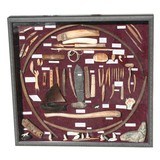 |
 |
 |

St. Lawrence Island Collection
Guns International #: 101406377 Seller's Inventory #: MLJ4
Category: Collectibles - Western - Collectibles - Native American
Seller's Information
When emailing or calling sellers direct, please mention that you saw their listing on GunsInternational.com
Seller: Cisco's Gallery
Company: Ciscos Gallery
Member Since: 9/2/16
First Name: Sam
Last Name: Kennedy
State: Idaho
Zip: 83814
Country: United States
Phone: (208) 769-7575
Fax: (208) 769-7575
Platinum Seller
Number of Active Listings: 538
Total Number of Listings: 7046
Seller: Private Seller
Return Policy: 3 day inspection and return policy on used guns.
Payment Types Accepted: Visa, Mastercard, certified funds, cashiers checks, money orders, and personal checks (items shipped when cleared). 3% surcharge on firearm purchases made with a credit card.
About Us: Cisco’s Rare & Exceptional deals in one-of-a-kind pieces that define America and the Wild West. The collection is both diverse and expansive, including historic antique western firearms, artifacts, antiques, fine art, and western home furnishings. Our store, located in scenic Coeur d’Alene, Idaho, is filled from floor to ceiling with pieces that spark romantic tales of the western frontier. Cisco’s inventory of authentic Native American art and artifacts is among the finest in the world featuring Navajo rugs, baskets, beadwork, totems, pipes, southwest jewelry and more!
Description:
St Lawrence Island. Extensive framed ivory collection by Kay Morse. Documentation included. 34" x 36".
ESKIMO ARTIFACTS ST. LAWRENCE ISLAND, ALASKA
Bucket handles ring the display. They seem to be whittled from walrus ribs, and after quizzing many knowledgeable Eskimos, one said they were used to carry the walrus hide box or bucket, which was used as the commode in the home. The children had the task of carrying it out daily to empty it. In the winter, they simply carried it out onto the ice and dumped it. It would go to sea in June. All these were found together.
Harpoon heads on the left top are of fossilized walrus ivory. These, I was told, are very old because they have tie holes worn by digging away the ivory with a sharp instrument. Later, when the bow drill method was invented, all such holes were drilled. Under the Ice Axes is an example of the assembled harpoon head. Also, there is the model showing all of the parts of the assembled harpoon. The harpoon was not used to kill the animal, only to secure it after it had been mortally wounded and could no longer dive for extended periods. An inflated seal skin, with its orifices sewed shut, was at the end of the line, assuring that once the harpoon was placed, the animal could be found near where the sealskin 'bobber' rose to the surface. An ivory simulation of the inflated seal skin is on the right, beyond the gut scraper.
On the right are three fish spearheads made of the oosik bone, the hardest bone in the walrus. They caught huge Arctic Char, to 20 pounds or more, and Slice fish, which are also large. The Island has rivulets deep in the tundra, which you can step across, but there may be these giant char lying there.
Ice Axes, as seen in the center, were used on seal hunts in the winter. While the Eskimo had to use skill to outwit the seal at the breathing hole, when he shot the seal, his work had just begun. He had to widen the opening in the ice large enough to pull the seal to the surface of the ice. The only wood available in the old days was driftwood from the beaches. The notch helped keep it in place when tied. The white axe is the remains of an axe that was washed by the sands on the beach for perhaps hundreds of years, so that only the pulp of the tusk is left.
The snow glasses are of driftwood, so light it must be cedar or redwood. When brought to me, they were heavy with moisture and could be carved with a fingernail. They are the only ones I have ever seen.
Stone tools are rarely found. I have no idea where the source of the slate was. To the right of the stone point is a gut scraper. They used a lot of sinews of gut to make fishing lines and ropes. The scraper was held in the palm and pushed along the split intestine to clean it of the undigested material. To its right is another unique piece, an ivory butt of the dog team whip. It was used to pull a dog back to its position when it had jumped the traces. The three-toothed comb on the left presented another quandary for the Eskimos to identify, but the best explanation was that it was used to split the fibers of the dry grasses they used to line their mukluks. They had socks of sealskin with the fur side in, and would place the grass insulation in the mukluk before slipping in the stockinged foot. Above the comb are some animal teeth put to use as tools. On the left is a button made from a walrus tooth, a needle of an arctic fox tooth, and a fishing weight, or perhaps a needle of a polar bear tooth.
Beside the comb are ice crampons used to get traction on the ice, though they usually had the clipped hair of the sole of their mukluks pointed to the rear, which allowed fair forward motion. To the right of the stone blade are two pieces of armor. The story was told that a princess lived in Gambel while her suitor, who had not won the approval of her father, lived in Savoonga. The arrows that were shot at the boy whenever he approached Gambel caused some concern, until he invented armor. The armor was of plates of dry walrus hide with these bone plates in between them, so the arrows had no way to reach his body. Let's assume that love won out.
On the right are various ivory needles and awls used to sew their leather clothing, and even the skin boats. One of the awls is shown mounted in a block of ivory used somewhat like a thimble to push with.
The baleen boat is from the baleen of the bowhead whale, made solely from baleen, the sail, the sides, and all of the lines. The baleen was what brought the whalers to Alaska, along with the desire for whale oil, to make the staves of the women's corsets. It was simply called whale bone. Whaling is still being done in the Bering Sea by the men of each village along the coast. Each village is allotted a certain number of 'strikes'. A strike is a hit with the lethal explosive harpoon, whether that whale is harvested or not. Success is measured by how many whales were harvested compared to the number of strikes. In the Spring, when pods of whales are due to pass nearby, camps are established out on the ice, school is out and the entire village supports their hunters. The whale blubber, or muktuk, is divided among the villagers by the whim of the crew captains. It is something you must acquire a taste for, nothing I would stand in line to get.
At the bottom are some art pieces made by the local Eskimos. The Arctic fox is mounted on the end of a very old ice axe. They say that ivory that turns black is approaching 10,000 years old. The snowy owls and eiders are common to the Island.
The Oosik is the hardest bone in the walrus. Most oosiks are marketed with ivory carvings on the ends, some very good, but too many showing a lack of art ability. This one is exceptional, and the only one I saw with multiple polar bear heads on a single end. They liked to carve the bear with its tongue out, saying that it is the way the male bear appears when it is breeding, as if the bear had an audience. Maybe some brave soul actually witnessed it. The oosik is the penis bone. It remains inside the body until it is put to use. It is the support for the actual penis, which looks like a giant summer sausage. While on the Island, a visiting Army officer suggested another way for the Eskimos to market the oosik. His idea was to put the head and front legs of a dachshund on the butt, or large end, and the hind legs and tail on the other. He asked that two or more rows of holes be drilled the length of the bone. The idea was to use it to serve hors d' oeuvrs.
At the bottom left is an ivory piece that has not been identified. It possibly served a second life as the top end of a drill or fire starter. The same is true of the tusk section on the right, an axe that was broken and then used as a fire starter.
The two embroidered sled dog heads are on urine tanned seal leather. Human urine was used to tan the leather used for much of their art work. They were predicting that the generation then producing this white leather by hand, kneading the leather in urine, and stretching it on wooden poles in the subzero winter sun, would be the last to undertake the ugly task. That was 1962.
Cisco’s complies with all State and Federal regulations regarding the commerce of ivory.
SOLD